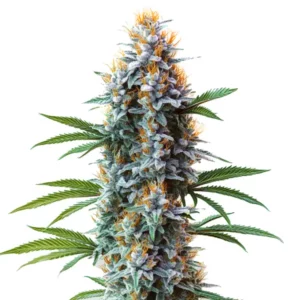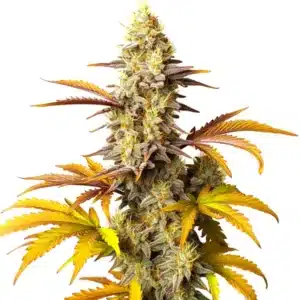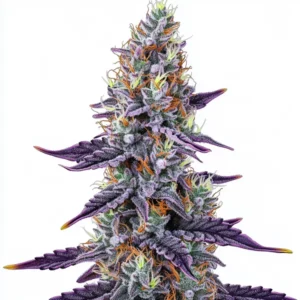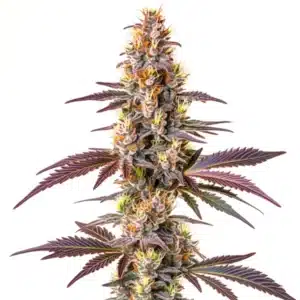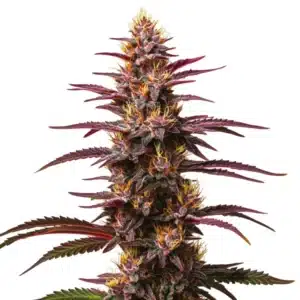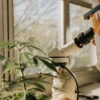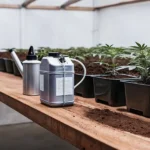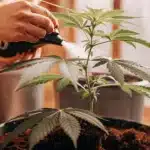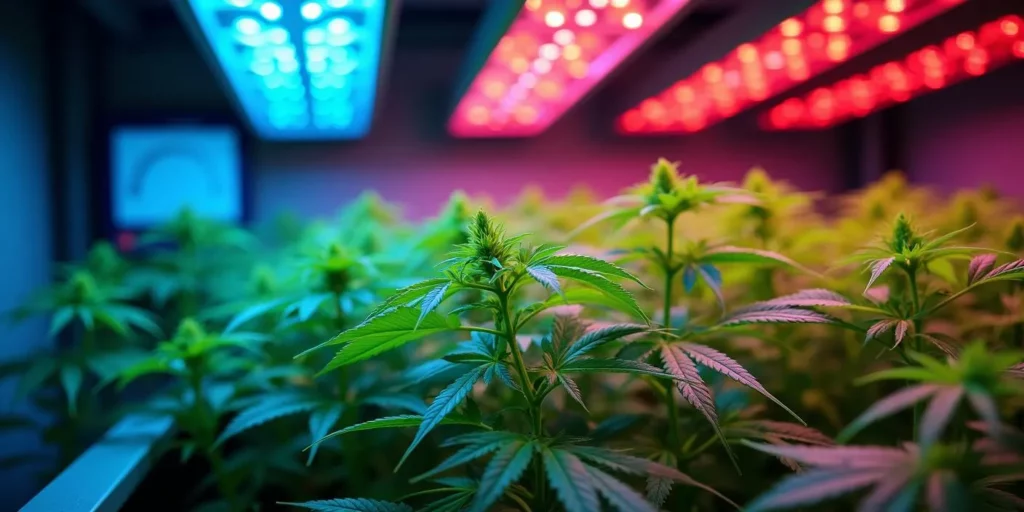
Best PPFD for Seedlings
When it comes to seedlings, the ideal PPFD (Photosynthetic Photon Flux Density) typically ranges from 100 to 300 µmol/m²/s. This level of light intensity supports healthy early growth while avoiding the risk of light stress. Exposing seedlings to PPFD levels above this range can lead to stress or damage, whereas insufficient light may cause weak or stunted development.
The journey of growing plants, especially cannabis seedlings, can be rewarding yet challenging. Knowing the function of Photosynthetic Photon Flux Density (PPFD) is crucial in this process. PPFD measures the amount of light that reaches the plant’s surface over a specified area, guiding growers in creating optimal lighting conditions. Understanding the best PPFD for seedlings can significantly enhance their growth and vitality by ensuring they receive the right amount of light at this delicate stage.
Recommended Strains
Blue Cheese
|
|
THC | 16% - 20% (Medium) |
|
|
Type | Feminized |
|
|
Yield | High |
|
|
Phenotype | 80% Indica / 20% Sativa |
Blue Cheese Autoflower
|
|
THC | 14% - 16% (Medium) |
|
|
Type | Autoflowering |
|
|
Yield | Medium |
|
|
Phenotype | 80% Indica / 20% Sativa |
It’s vital to recognize that not all plants have the same light requirements, especially at different growth stages. Seedlings have unique needs that are essential for proper development. So, what exactly is the optimal PPFD for seedlings? Let’s explore this fascinating topic, ensuring your little green buddies thrive!
What is PPFD?
PPFD represents the amount of light photons available for photosynthesis at the plant level, commonly measured in micromoles per square meter per second (µmol/m²/s). This measurement helps growers understand how effectively their light sources support photosynthesis, which is the process that allows plants to convert light into energy.
For seedlings, achieving the right amount of PPFD is essential. Insufficient light can lead to weak, leggy seedlings that stretch toward the light source, while excessive light can cause stress, ultimately hindering growth. Thus, understanding PPFD is crucial to nurturing healthy plants.
Promos & Deals
Best PPFD for Seedlings
The optimal PPFD for seedlings generally ranges from 200 to 400 µmol/m²/s. This balance provides sufficient light intensity to encourage healthy growth without overwhelming young plants. By mimicking natural sunlight conditions, this range ensures that seedlings can efficiently perform photosynthesis and flourish.
To achieve these levels, consider adjusting the distance between the light source and your seedlings. Starting with the light set at a distance that allows for healthy growth is critical, and you can make adjustments based on how your plants respond over time. As your plants transition to the flowering stage, it’s important to aim for the best PPFD for flower to maximize bud development and yield.
Why Light Intensity Matters
Understanding why light intensity is vital can transform your seedling care routine. Light intensity directly affects the efficiency of photosynthesis. During the seedling stage, plants are forming crucial structures such as leaves, stems, and roots. If light is too weak, growth can stall significantly. However, too much light can stress seedlings, resulting in various growth problems.
Keep a close watch on your plants. If you notice stretching or pale coloration, this signals that the light may be insufficient. Conversely, yellowing and crispy edges on leaves are often signs of too much light. Observing and adjusting accordingly is the key to healthy seedlings.
Choosing the Right Light Source
The type of lighting you select is fundamental in affecting PPFD levels. Many growers prefer LED lights because they are energy-efficient while producing specific light wavelengths. For those just starting, fluorescent lights can provide a softer light and create a nurturing environment for seedlings.
It’s also beneficial to select light sources that allow for height and intensity adjustments. This flexibility enables you to fine-tune the PPFD according to the growth stage of your seedlings, ensuring they receive the right amount of light for optimal health.
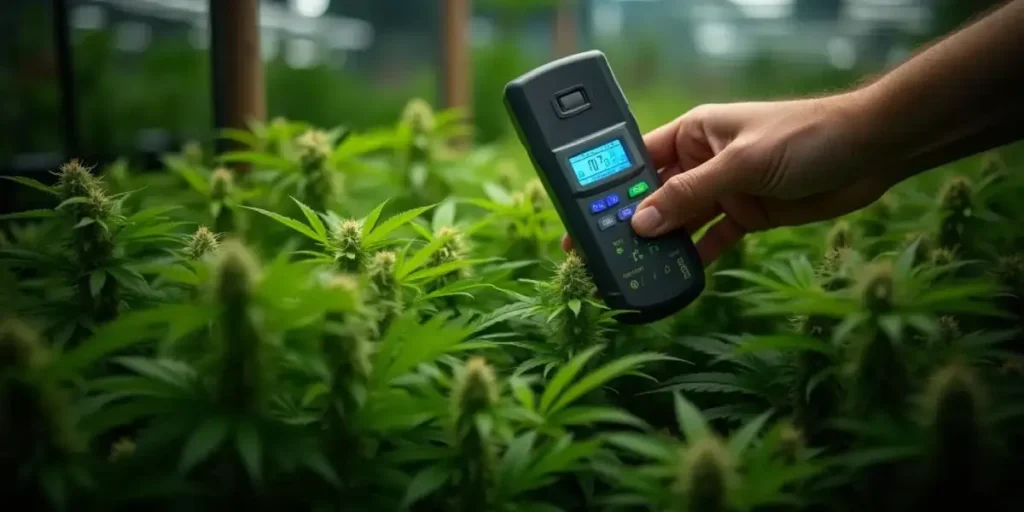
Factors Influencing PPFD
Several elements can influence the actual PPFD your seedlings receive. One significant factor is the distance between the light source and the plants. The closer the light is to the seedlings, the higher the intensity. Be careful, though; too much proximity could create heat stress if not monitored.
Additionally, using reflective surfaces around your growing area can boost PPFD levels. By employing reflective materials, you can distribute light more evenly, ensuring that all seedlings enjoy adequate exposure and maximizing their growth potential.
Measuring PPFD
If you want to ensure your seedlings are getting the right light, investing in a PPFD meter can be a wise decision. This handy device provides accurate measurements of light intensity at the canopy level of your plants. It’s an essential tool for any serious grower.
Regular monitoring is vital for maintaining the best conditions. If you notice significant fluctuations in your readings, it may be time to reassess your light setup to better meet the needs of your seedlings. After all, thriving seedlings contribute to a successful growing experience.
Light Schedules for Seedlings
In addition to PPFD, maintaining a consistent light schedule is key to seedling health. Providing 18-24 hours of light each day is common to promote robust growth. However, seedlings also require dark periods to rest and recharge. Finding the right balance between light and dark is crucial.
A popular choice among growers is an 18-hour light and 6-hour dark schedule. This setup helps safeguard seedlings’ health while supporting their natural growth cycles, ultimately leading to a more successful endeavor.
Common Problems Related to Light Intensity
It’s important to understand that merely achieving the correct PPFD isn’t enough. Both underexposure and overexposure to light can result in various complications. Issues such as light burn or nutrient deficiencies may arise if seedlings are kept outside their ideal light conditions.
If you observe phenomena like curled leaves or the appearance of dark spots, it may indicate light stress. In contrast, seedlings that exhibit leggy characteristics and a pale coloration might need an increase in light exposure to thrive. Proactive observation can help you identify and rectify these issues before they escalate.
Adjusting Light Levels
One of the simplest ways to manage light levels is to adjust your fixtures. For dimmable lights, consider decreasing the intensity if your seedlings seem distressed. Alternatively, if your seedling displays signs of stress, raising the light by a few inches can provide immediate relief.
Many growers experiment with different lighting setups to discover what works best for their specific strains. Keep in mind that various strains, such as Blue Dream or Northern Lights, may respond differently to light intensity. Therefore, being flexible and adjusting accordingly can lead to great success.
The Importance of Observation
Regularly observing your seedlings is paramount for their growth. Create a habit of taking notes on how seedlings respond to varying light intensities and positions. Track changes in color, leaf shape, and overall vigor, as this kind of data can be invaluable for refining your growing practices. As your plants mature, understanding the best PPFD for flowering will help you optimize light levels and maximize bud development during the bloom phase.
By documenting these observations, you will create a more tailored growing environment that meets your specific conditions. Remember, nurturing successful seedlings often involves adapting based on their feedback!
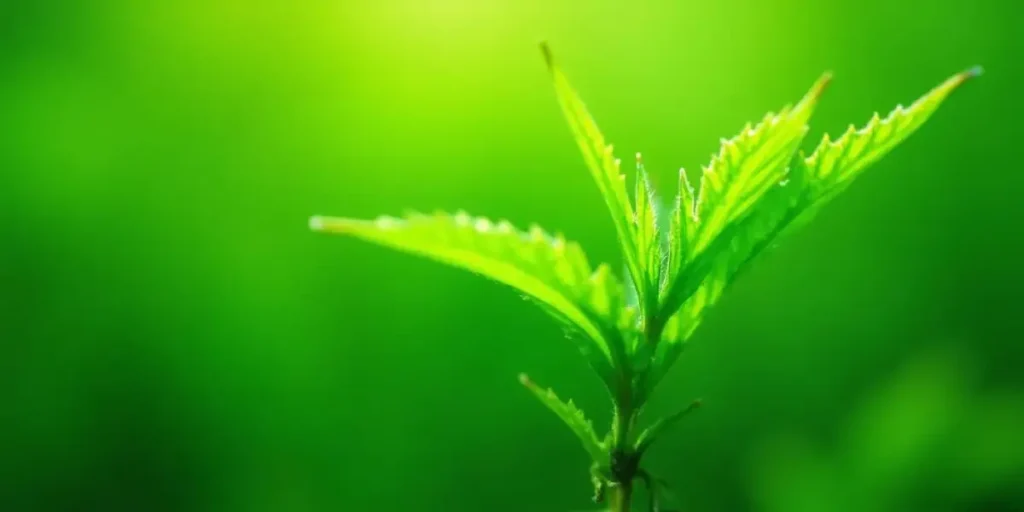
Recommended Light Sources
For newcomers, choosing the right light source can feel overwhelming. Here are some popular options that effectively provide the necessary PPFD for seedlings:
- LED Grow Lights: Highly favored for their energy efficiency and ability to emit specific light spectrums, look for models that allow height adjustment and dimming for optimal control.
- Fluorescent Lights: These lights are an excellent choice for beginners, producing lower heat levels and suitable for a wide range of plants.
- HID Lights: High-Intensity Discharge lights can deliver high PPFD, but they generate significant heat, which may require additional cooling strategies.
Choosing the right light source is essential for fostering vibrant seedlings and productive growth. Take time to research and compare options, keeping in mind your setup space, energy efficiency, and the unique needs of your plants.
Seedling Care for Optimal Growth
Along with monitoring PPFD, proper seedling care is paramount for their overall health and development. Ensuring adequate moisture, nutrients, and airflow is crucial. Maintaining soil that is moist but not waterlogged is key to promoting healthy roots. Overwatering can lead to root rot, while underwatering can stunt growth and development.
During the seedling stage, fertilization should remain minimal. Gradually introduce nutrients as the plants mature to avoid overwhelming their sensitive systems. Utilizing organic fertilizers can keep the plants healthy and promote an overall vibrant growing environment.
Choosing Robust Strains
When selecting cannabis seeds, opting for strains known for their resilience and adaptability can yield rewarding results. Strains such as Green Crack, Gelato, and White Widow not only thrive in optimal conditions but also provide gratifying growth experiences for growers.
Selecting the right strain will create a solid foundation for your growing endeavors, making the management of your plants easier while maximizing the quality and quantity of your yields.
Maintaining a Healthy Environment
The environment surrounding your seedlings is just as vital as their light conditions. Ensuring proper ventilation and air circulation within your grow area can prevent mold and create conditions for healthy growth. Good airflow helps support nutrient uptake and maintains strong seedlings.
Alongside light and airflow, temperature and humidity levels are critical. Seedlings usually thrive in temperatures between 70°F and 80°F (20-27°C). Keeping humidity around 65-70% can promote healthy growth and prevent complications, ensuring your seedlings remain vigorous and productive.
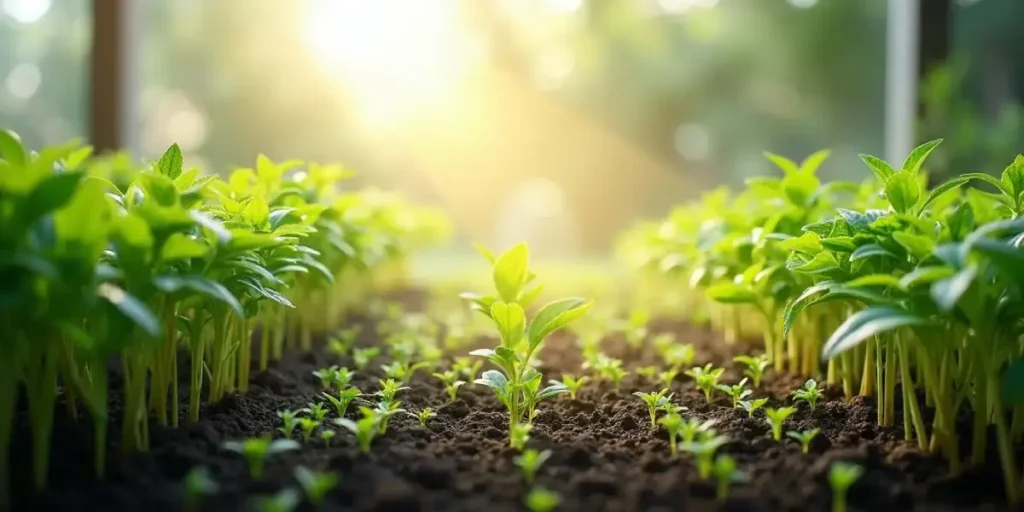
FAQs about best ppfd for seedlings
What happens if my seedlings get too much light?
When seedlings are exposed to excessive light, they may experience light burn. This typically manifests as yellowing or browning on the edges of leaves. To rectify this, reduce the light intensity or raise the light fixture to alleviate stress.
How can I tell if my seedlings need more light?
Signs such as leggy growth, where seedlings stretch tall and appear pale, indicate that they might require more light. If you observe these symptoms, it may be time to boost light levels or adjust your growing setup.
Can I use sunlight for my seedlings?
Sunlight can be beneficial for seedlings, but it’s crucial to ensure that they don’t receive too much direct exposure too quickly. Incorporating indirect sunlight or supplementing with artificial lights can create a more balanced light environment for optimal growth.
How often should I adjust my light settings?
Light settings should be adjusted based on the growth progression of your seedlings. Regularly monitoring their development and environment will help you assess when alterations are necessary to maintain optimal conditions.
Are there specific strains that perform better in low light?
Some strains, like Critical Mass and Lowryder Auto, are known to adapt better to lower light conditions compared to others. However, it remains true that most strains will benefit from receiving appropriate light levels and nutrients tailored to their specific needs.


